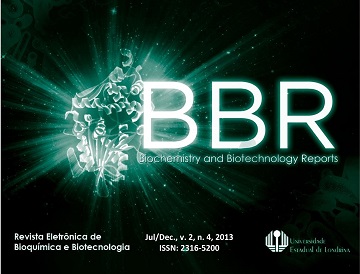Application of carboxypeptidase from Rhizopus on ochratoxin A degradation
DOI:
https://doi.org/10.5433/2316-5200.2013v2n4p30Keywords:
Mycotoxin degradation, micro-organism, enzymatic hydrolysisAbstract
Mycotoxins are secondary metabolites produced by filamentous fungi in different food chain stages. Among mycotoxins, ochratoxin A (OTA) is of great importance, and presents carcinogenic, teratogenic and nephrotoxic effects. These effects have motivated the development of methods to reduce the contamination levels to the allowed levels. Biological methods involving the use of enzymes and microorganisms for OTA degradation has excelled due the specific reaction and mild conditions for detoxification. In this work we established conditions for the extraction of carboxypeptidase A from fermented biomass by Rhizopus oryzae in order to employ it in the OTA degradation, using pancreatin as control. The standardized methodology for enzymatic extraction consisted of ultrasonic agitation for 30 minutes in a fixed power of 150 W and 40 kHz. The enzyme extract of the microorganism showed a degradation capacity of 19.4%, which caused degradation higher (49%) than the one found during pancreatin action. This result confirms the advantage of using microbial enzymes over those from vegetables including micotoxycology biodegradation processes.

